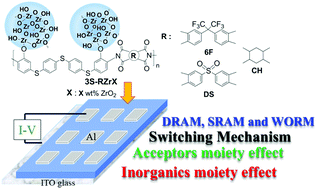Novel solution-processable functional polyimide/ZrO2 hybrids with tunable digital memory behaviors†
Abstract
A series of solution-processable sulfur-containing poly(o-hydroxy-imide)s 3SOH-RPI with pendant hydroxyl groups and the corresponding 3SOH-RPI/ZrO2 polyimide (PI) hybrids were synthesized from the diamine 3SOH-DA and dianhydrides of CHDA, 6FDA, and DSDA, respectively, for memory application. By introducing acceptors with different electron-withdrawing capabilities (CHDA < 6FDA < DSDA) into polyimide backbones, the obtained polymer memory devices show the memory behaviors of none, DRAM, and SRAM, respectively. In order to facilitate and enhance the memory effects, different amounts of ZrO2 were incorporated into 3SOH-RPI to investigate the corresponding memory properties. The hydroxyl groups on the backbone of 3SOH-RPI could provide reaction sites for organic–inorganic bonding and the homogeneous hybrid thin films could therefore be obtained by controlling the mole ratio of zirconium butoxide/hydroxyl groups via a sol–gel reaction. The resulting PI hybrid films displayed electrically programmable digital memory properties from DRAM, SRAM, to WORM with a high ON/OFF current ratio by controlling the content of ZrO2 from 0 wt% to 30 wt%. Moreover, in order to deeply confirm the memory switching mechanism of 3SOH-RPI/ZrO2 hybrids, the devices fabricated both from PI/ZrO2 and PI/TiO2 hybrid films were used to demonstrate the effect of LUMO energy levels of ZrO2 and TiO2 on the memory characteristics and retention time in this study.


 Please wait while we load your content...
Please wait while we load your content...